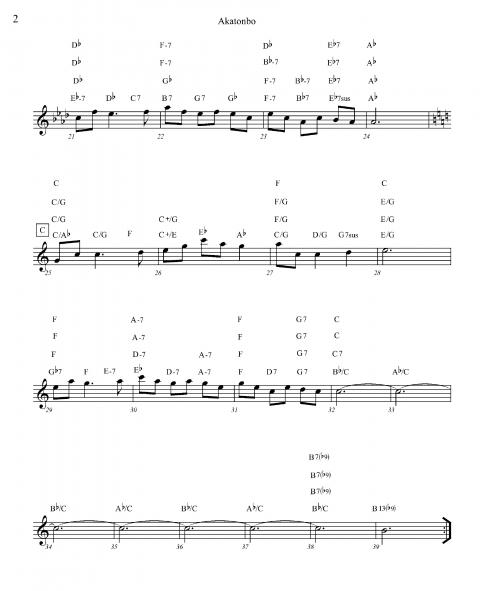Let your Ear and your Heart Lead
For this lesson on my approach to reharmonizing, I’m going work with an old Japanese song titled “Akatonbo.” I generally do a reharmonization in several steps. To show the whole process, I’ve recorded solo piano versions of the tune documenting each stage (listen to the examples at https://soundcloud.com/soundsofberklee/sets/akatonbo-examples-from-the-…). First, listen to example 1, which is “Akatonbo” played with a basic, diatonic harmonization. Next, listen to example 5 to hear the final product. As we go through the steps in between, listen to the musical examples of each one. I’m going to break down the tune to four-bar phrases to explain my ideas. The music appears on page 21, and the chord changes for each step are listed above one another over each bar.
Step One: Structure
In the first step, I created a tune structure by harmonizing the three sections in three different keys (listen to example 2). Each modulation moves up a major third. The chords used for this first step are the same as those used in the basic diatonic harmonization of the melody heard in example 1. I simply restated the melody using the identical functions of the basic harmonization in the keys of E, A-flat, and C. To balance the tune artistically, I added eight bars after the statement in the third key (C major) in bar 32. This enabled me to insert the dominant chord (B7) to set up the return to the top of the tune in E major. The material from these eight bars provided a perfect introduction for the tune that I used in step four.
Step Two: Emotional Intent and Balance
At letter A, in bars 9 to 12 of the second step, I used what I call an “emotional intent,” a surprise chord in bar 12 (listen to example 3). Your own artistic taste will dictate how subtle or far out this chord choice should be. I decided to make it sweet and subtle, which is in keeping with the general atmosphere of the tune. In bar 11, the surprise chord is a dominant chord (G#7 or Ab7, which is the dominant of the Db chord that follows in bar 12). It was a matter of preference to make it a sus 4 chord instead of a straight dominant seventh.
In approaching bars 13 to 16, I thought about root motion and substituted a D chord for the A chord in bar 13 of the basic harmonization. Hence, the Db in bar 12 resolves up by a half-step to the D chord in bar 13. I didn’t make other changes to bars 13 to 16 to preserve a sense of balance in the tune. This gives time for things to resolve naturally.
In the next B section, in bars 17 to 20, I started working backward from bar 20. In that bar, I employed another emotional intent: the A-7 (see bar 20). This time, instead of using the dominant chord in the approach, I used parallel harmony (Bb-7 moves up in parallel motion to A-7). The Bb-7 is the related minor chord corresponding to the Db chord (the IV chord in the original harmonization), making this a smooth transition. I liked this idea and decided to do the same in bar 17 and use an F-7 (the relative minor of the Ab or I chord in the original harmonization). I would characterize this as a slight emotional intent. It also expands the sound of parallel harmony, because all chords in bars 17 to 20 are minor-seventh chords. Working backward in this section was very useful.
In the next four bars, 21 to 24, the only change from the original harmonization happens in bar 23. I like the sound of II-V root motion, so I substituted a Bb-7 for the Db here.
For the section in C major (bars 25 to 32), I used a pedal point on a G in bass under the C chord in bar 25 and maintained it for four bars. In bar 27, the G works well under the F chord, setting up the expectation that it would resolve to the tonic, or C chord. As we approach the end of the form, I wanted to build some tension, so I changed the C chord of the original harmonization to an upper-structure E triad over the G pedal.
For the second half of this section (bars 29 to 32), I made no changes to the original harmonies to allow the natural tune to wind down after the tension created in bar 28.
Step Three: Harmonic Rhythm and Displacements
For this pass, I concentrated on creating a balance in the harmonic rhythm of my chord changes (listen to example 4). To create balance, I needed a chord change on bar 10, so I displaced the A chord that occurred in bar 11 in the original, using it earlier and filling bar 11 with an F#-7 (the minor chord related to the A chord). After introducing the F#-7 in bar 11, I decided to revisit it in bar 14, substituting it for the C#-7 of the original.
At the key change to Ab for bars 17 to 24, I displaced the F-7 that was in bar 17 in the original to bar 18. By using a C in the bass of the Ab chord in bar 17, the bass notes move in fifths in bars 17 to 19.
For the second phrase of this section, I displaced the F-7 from bar 22 in the second step to bar 23 and followed that with a Bb-7 on beat two. The Gb chord in bar 22 is a simple chromatic approach to the F-7 in bar 23.
As we go to the key of C in the C section for bars 25 to 32, I stayed with the idea of a bass pedal used at this place in step two and added a new chord: a C-diminished triad above the G pedal in bar 26. I found this chord by experimenting with voice-leading or intermelodic motions (see the sidebar “Christan Jacob’s Rules” on page 21).
For the second phrase of this section (bars 29 to 32), while being mindful of the pace of harmonic development I’ve set up, I displaced A-7 that fell on beat one of bar 30 in step two to the third beat. I filled in beat one with a D-7 (related to the F in bar 29).
Step Four: More Displacements and Harmonic and Root-Motion Techniques
For the final step, I polished my introduction (taken from bars 32 to 39). Over a C bass pedal, I alternated between Bb and Ab upper-structure triads over the pedal and finished the intro with a B13 (b9) displaced by a bar. This voicing also uses an upper-structure chord.
For the final harmonization of the A-section melody, I placed chords on every beat (listen to example 5). I used parallel structures in bar 9 with a scattered root motion and then II-V, or circle of fifths bass-note motion, in bars 10 to 11. In bar 13, a tritone leap between the D and G#7 chords continues the scattered root-motion idea. I displaced the F#7 of step three in bar 14 by a beat, preceding it with an F augmented chord that moves upward by a half-step. On beats two and three of that bar and the next, the roots move in fifths.
In bars 17 to 20, the root motion becomes more melodic. There are displacements of the Ab/C to beat two of bar 17 and the F-7 to beat two of bar 18. I precede these changes with a mix of related chords and root motions. Bars 21 to 24 are notable for additional displacements, and the circle of fifth-root motions appear in bars 23 to 24.
Beginning in section C in bars 25 to 28, I used a displacement of the C/G chord in bar 25 and broke up the G bass pedal pattern that was used in bar 26 of step three. The pedal resumes in bar 27. For the final phrase of the melody, bars 29 to 32, I employed displacements in bars 29 and 30 and chromatic-root motion that I had previously avoided. The chromatic line adds new life. In bar 31, I used a II-V approach for the final root progression before arriving at the C pedal in bars 32 to 38.
I could have provided more information about the reasons for each chord choice in step four, but given space limitations, this is all the detail I can offer. The sidebar on my reharmonization rules and tools gives extra insight into my thinking. The reharmonization used in step four can be heard on the version of “Akatonbo” that appears my latest CD, Christian Jacob Trio: Live in Japan. I hope the ideas presented here are helpful as you create your music.
Christian Jacob is the pianist in the Tierney Sutton Band, and has performed with and arranged for such artists as Flora Purim and Airto Moreira, Maynard Ferguson, and Bill Holman. He is featured on eight albums with Tierney Sutton and has released five CDs under his own name. Visit www.christianjacob.com.

Akatonbo Pg. 1

Akatonbo Pg. 2




